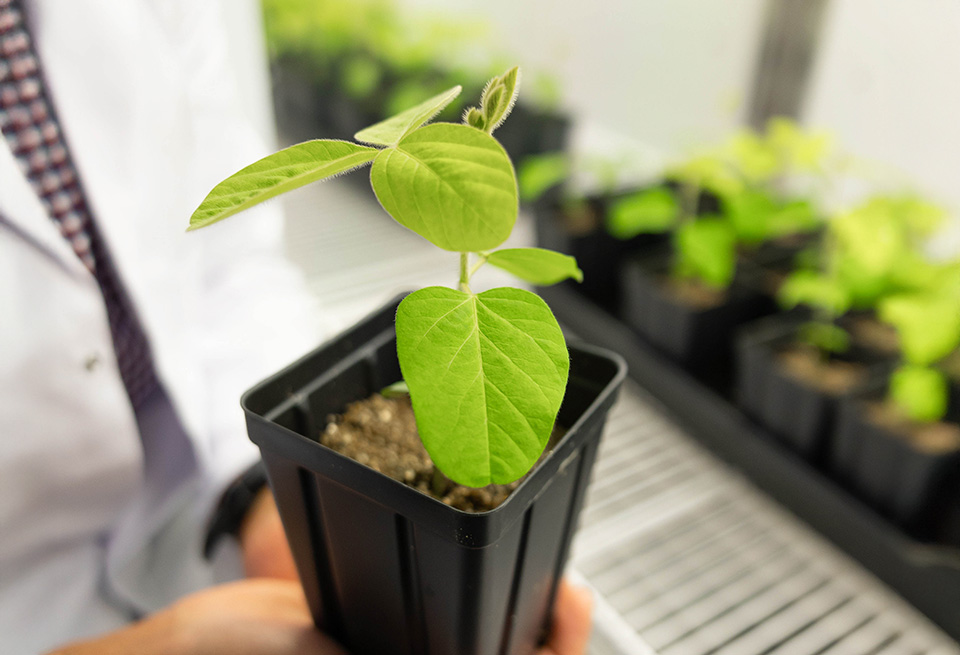
(Photo: Iowa Soybean Association / Joclyn Kuboushek)
Protecting seed innovation
August 29, 2025 | Bethany Baratta
It's difficult to determine just how much yield would have been lost had soybean varieties with PI88788 soybean cyst nematode (SCN) resistance not been made widely available to farmers in the late 1990s. Today, Iowa soybean growers have over 900 SCN-resistant varieties from which to choose. It's because of the available germplasm — the genetic diversity that exists in our collections of plant introductions, land races, different soybeans, and wild relatives collected from around the world — that breeders are able to develop these resistant varieties to protect soybean yields.
Over the years, breeders have tapped into the National Soybean Germplasm Collection at the Agricultural Research Service lab in Urbana, Ill., to develop soybeans with valuable traits, like improved drought tolerance, by crossing multiple lines to build better performing plants, according to Michaela McGinn, director of sustainable production with the United Soybean Board.
"The SCN resistance sources Peking and PI88788 — both identified and developed by researchers/breeders — have shaped the body of work targeting soybean's number one yield-robbing pest. The discovery and deployment of rhg1 and rhg4, the key genetic regions found responsible for SCN resistance, have made it possible to widely incorporate resistance into commercial varieties," she says.
"The Kingwa line, also sourced from the collection, was the parental line researchers and breeders used to build soybean resistance to Phytophthora, a pathogen that causes root and stem rot in soybeans. Additionally, the repository provides data to the Germplasm Resources Information Network, which lets scientists track how soybeans have changed both on the outside (traits) and inside (genetics), guiding better decisions for the future of agriculture." McGinn adds.
This seed bank houses thousands of unique soybean lines from around the world, including some from China, where soybeans were first grown. Many of these are old, wild types or land races, not the kind farmers would use to break a yield record today.
"These lines may not be your next high-yielding variety, but they are often the key to natural resistance — against sudden death syndrome, soybean cyst nematode, and other pressures that farmers face in the field," says Joe McClure, chief officer of the Iowa Soybean Association's (ISA) Research Center for Farming Innovation (RCFI).
Public and private researchers tap into the seed bank regularly. The germplasm is used in breeding, crossing heritage lines with newer lines to breed for specific resistance and other desirable traits. McClure reported more than 20,000 seed distributions go out to breeders who use these lines as raw material for innovation.
Funding in jeopardy
The U.S. Department of Agriculture (USDA) Agricultural Research Service (ARS) maintains the National Soybean Germplasm Collection. As of press time, the USDA's proposed budget for FY 26 calls for the closing of this center and others in California and Delaware and shifting their work to other ARS labs.
The potential withdrawal of federal support for the soybean germplasm repository and for germplasm curation across all crops is concerning, says Ed Anderson, executive director of the North Central Soybean Research Program (NCSRP).
"Federal funding for basic and applied research is being eroded," he says. "If support for germplasm preservation disappears, we're slipping. We lose our edge as the most innovative and reliable agricultural system in the world."
Unlike a private breeding program, where companies protect their own genetic material, the germplasm repository is a public resource.
"It's not just seeds in a bag in a freezer," Anderson says of the repository. "Seeds don't last forever. They have to be grown out, harvested, and cataloged. That takes expertise, land, and long-term commitment. And most importantly, it takes funding."
A living system
McClure compares the germplasm repository it to a bank. "You're not just making withdrawals. You have to reinvest to keep it viable — and that means repopulating the seeds, making sure the data and traits are tracked, and distributing clean, uncontaminated lines."
Every seed sent out is one step in the breeding process that ends with better varieties in the hands of farmers. Public breeders like Dr. Danny Singh at Iowa State University rely on the repository to discover novel traits.
What's at stake?
Without support for the repository, the pipeline of new traits — especially those that come from natural resistance — will dry up. That means fewer tools to fight emerging diseases, fewer options to adapt to a changing climate, and more reliance on expensive, engineered solutions, Anderson says.
"Most of the genetic base in today's commercial soybeans comes from 14 to 17 original parents," says Anderson, who retired as the senior director of research at ISA in 2023. "But there are thousands of untapped lines in the repository. Each one could be the key to solving tomorrow's problem.
Anderson, McClure, and advocates hope funding remains, but the germplasm repository's long-term future remains uncertain.
"This is checkoff dollars and public effort working together in the best way — nonpartisan, science-based, focused on what matters for farmers," Anderson says. "Without these basic resources, we don't feed the research pipeline. And without that, we don't feed the world."
Written by Bethany Baratta.
Back